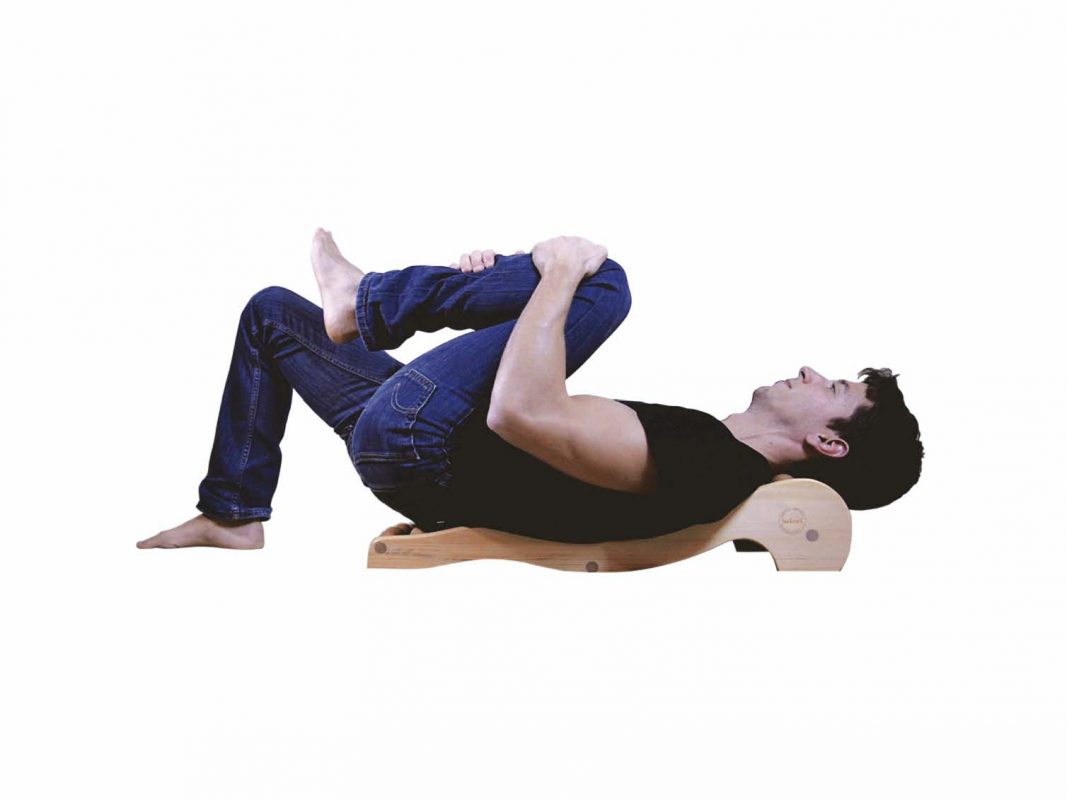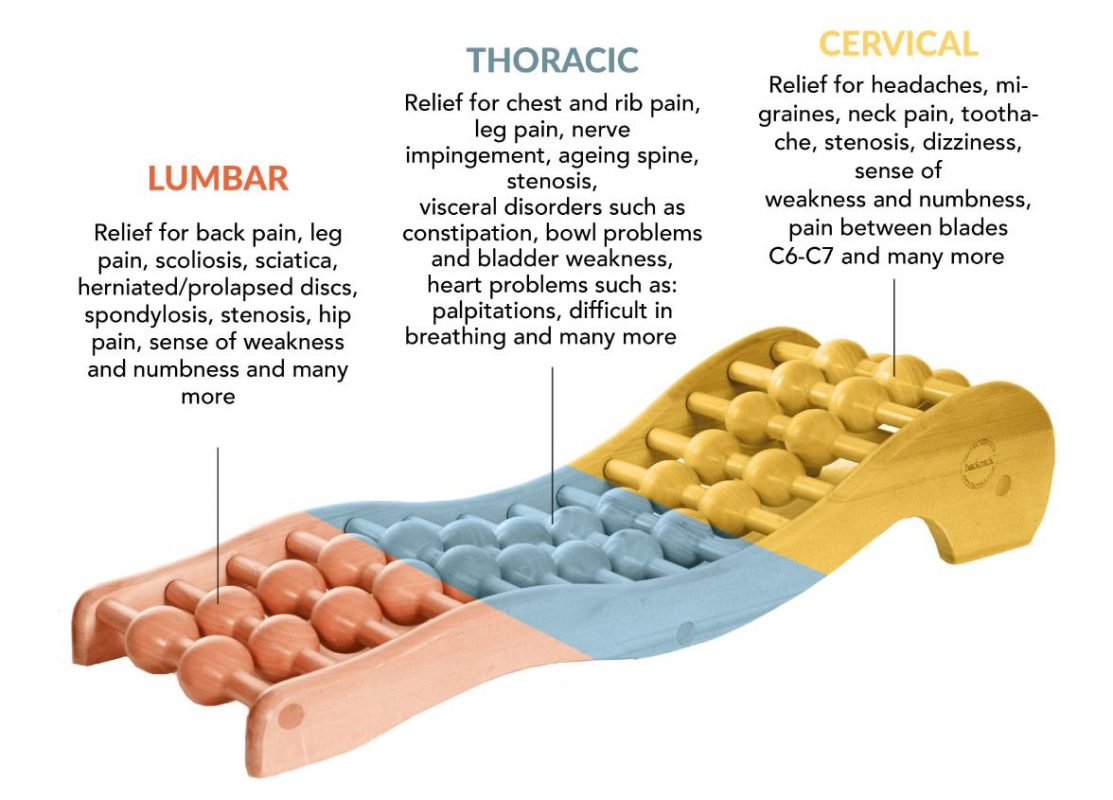 Spinal Decompression Device
Spinal Decompression Device
Based on patented Backrack technology, the Backrack is a decompression device designed for home use to help you get back pain relief, safely without supervision in the comfort of your own home. It works on the whole spine (cervical, thoracic and lumbar regions) and through following a specially designed program of exercises the Backrack can treat not just the symptoms but the causes of back pain. It has a unique concept and application in back care. Backrack mirrors the natural curvature of the spine. As a result, the back is fully supported.
The Benefits Include:
• Pain relief and stiffness
• More flexibility and mobility
• Complete relief from muscular pain and tension
• Absolutely no side-effects
Designed by Harley Street specialists to help reduce your back pain
DESCRIPTION
Backrack™ is a unique worldwide product for back pain relief. Endorsed by world top spinal specialists and incorporating worldwide patented technology, it is truly a stand–-alone product in back care. Backrack™ tackles the cause of your back pain instead of masking the symptoms like other products, so you can expect lasting results helping you avoid the need for more aggressive forms of treatment, such as surgery. Medical professionals are now using Backrack™ to treat sciatic nerve and other lumber related problems where sports coaches & physiotherapists only recommend Backrack™ for lower back pain relief.
WHO IS THE BACKRACK FOR?
The Backrack™ is for anybody that suffers from cervical (neck pain), thoracic (middle back), lumbar pain (lower back pain) or any of the symptoms associated by it. Unlike costly ineffective on going treatments and devices that only mask the symptoms of back pain short-term, BackRack directly targets the cause so for just one investment, you can expect a long-lasting solution and a pain relief.
It helps reduce and prevent spinal conditions including
• BACK PAIN • AGEING SPINE • STENOSIS
• SCIATICA • LEG PAIN • HEADACHES
• HIP PAIN • NERVE IMPINGEMENT • PROLAPSED DISCS
HOW IT WORKS
All back pain is caused by bone deformity directly linked to compression.
This is when your spine becomes squashed or shortened from its natural length.
Backrack™ works directly on the cause of back pain by decompressing your spine. By treating the cause rather than just the symptoms, you can banish back pain – for good. It has a unique concept and application in back care that ensures back pain relief.
If your condition is not listed or unsure if the Backrack is suitable for you? Contact us and we can advise
Who’s at the risk of developing Back Pain?
A number of significant factors can be named as ageing, genetics, work hazards, lifestyle, obesity, posture, pregnancy, and smoking. If these don’t surprise you then this will; you can even encounter a back pain with none of these risk factors. Prior prevention is the only element in such factors that can help.
Ageing
Ageing over time is itself a factor for some patients. Wear and tear to the spine can lead to conditions like disc degeneration and spinal stenosis. This is followed by neck and back pain. That clearly means younger people are at lesser risk than individuals over the age ageing over 30 or 40. Disc-related disorders are commonly observed in patients ageing from 30 to 60. While osteoarthritis is commonly pain related syndrome that will strike people with.
Genetics
Genetics are crucial in identifying back pains. The genetic component is evident in some of the spinal disorders. Degenerative disc disease is observed to have an inherited component when we talk about genetics.
Occupational Hazards
There are some jobs that follow a hazardous routine. It includes repetitive bending and lifting. People doing such jobs are at a high-risk factor for back related injuries. These may usually include professions like construction work, nursing, and few more. There is also an exception of higher risks of back pain to people who has a poor posture. That have longer job hours while constantly standing (a barber) or sitting back on a chair (software developer).
Sedentary Lifestyle
People with no or less physical activity are at the brink of back pain too. The occurrence of the pain becomes likely due to lack of regular exercise. Such patients develop severity of the pain than usual patients.
Excess Weight
Overweight is a major contributor towards back pain by increasing stress on the back and other joints. That may lead to further side effects for special category back pain symptoms.
What Can Go Wrong with the Lower Spine?
Bending and twisting of everyday life activities is only possible due to a healthy working spine. The spine is a weightlifter of the upper body. While flexing and rotating of the hips while walking is controlled by muscles in the lower back. These also support the human spinal column. Legs, feet, and pelvis get their sensations and power from nerves down the lower back. Injury to the ligaments, joints, discs or muscle tension may result in chronic low back pain that can further make the pain worse. The result of an injury sends a healing response to the body through mobilising. This inflammation might be healing but can cause a severe pain that will need an immediate medical advice.
Due to a large network of nerves overlapping it becomes difficult for the brain alone to realise the exact cause of the pain. This due to a large system that includes the formation of discs, muscles, and ligaments. Consequently sensing becomes difficult for the brain. For example, sciatica pain a type of acute low back pain caused due to a problem to the sciatic nerve (a large nerve running down hips and back of the leg). Inflammation may come from this pain or a pulled muscle in the same area. Muscles and ligaments usually heal rapidly but sciatica pain relief may be difficult to maintain. The course of time determines how the doctor is going to treat back pain.
There are many things that can go wrong with the spine, but, in essence, up to 98% of all back pain is either caused by, or directly linked to, compression. That is the term used to describe the spine when it becomes squashed, or shortened from its natural length.
Root Causes of Back Compression
Gradual Wear and Tear on the bones and tissues with the passage of time can be addressed as the basic cause of Back Compression.
There are some definite factors contributing to back compression. That occurs suddenly and rapidly regardless of age. These can be well categorised as:
Sciatica
Sciatic nerve is the Punisher in this case. Direct compression on the sciatic nerve can cause a form of radiculopathy. An intense burning like sensation down the back combining buttocks pain and back of the leg. Often reaching for the foot. The nerve is large lining down the buttocks reaching all the way down to the back of the leg. Things worsen when pain combines numbness and weakness in the muscle. This becomes possible due to blockade nerve signals. A tumour knows as the cyst is also known to cause such condition by pressing the sciatic nerve and surrounding roots.
Herniated or Ruptured Disc
Compression and Bulging outward (herniation) of intervertebral discs causing the lumbago.
Neck or Cervical Pain
The cervical spine can support ahead with the weight of 15 pounds or more. It is a complex structure with greater flexibility as compared to other regions of the spine. With such freedom of movement, it allows the head to be moved in several directions. This flexibility can often bring along pain and injury due to a number of reasons including compression.
Hip Pain
Buttocks pain can be easily identified when a person moves or walks with a limp. This pain is a result of the pinched nerve in the hip following a burn or tingle. Tissue pressing on the nerves usually bring along tingling sensations and weakness. This is due to the usage of back muscles in place of the leg and thigh muscles. I aim to lift large, heavy objects a herniated disc can occur. Twisting and turning can lead to the problem too. A blow to the back or sudden fall is seen to cause the herniated disc.
BACKRACK™ – Say Good Bye to Ouch moments Once and forever!
If we can decompress the spine, we can treat the causes, and hence the symptoms, of back pain.
The recent advancement and technology have made possible the birth of a convenient tool for back decompression. The treatment is finally here for all roots of back pain with the name of ‘Backrack™’. This handy spinal decompression device is the lifesaver of millions due to its vast applications in back pain treatment. Back pain is common among people throughout the world. We all have an encounter with this pain at some point in our lives. Times can become difficult when the pain arises.
Design
The design is quite familiar to the healthy human spine. It is more structured and flexible. The rack is well built with An ‘S’ shape in the making. It consists of waves structured up and down throughout in a straight line. A frame gives it the overall rack shape and provides support and stability with respect to the floor.
Build
Stability is crucial in dealing back compression which strictly applies to this product. This helps in relieving the tension of the muscles formation of the spine. If stability is not well maintained it will result in further injury or misalignment. This is where the product becomes useful by providing a structured support.
Efficacy
If your condition is worse it might be difficult for you in the beginning to use the ‘Backrack™’. You will be required to get down on the ground in a stable position. You will then be required to move aside gently on the rack and sit on the wooden ridge. This is where the spherical wooden balls show their magic by automatically positioning themselves on either side of your spine. The spine would then get the support from the wooden nodules all the way up to the neck. At this point, you will be required to keep your knees bent by lying your body comfortably on the rack. Maybe imagine a sunny vacation on an exotic resort. Just sit back and relax. At first, it will bring along some discomforts due to the solidity. But as time progresses your spine will automatically ease itself in accordance with the rack. The best feature of the product is it’s all in all build not only for lumbar but thoracic and cervical areas.
Application
Whatever may be the risk factors of developing the pain ‘Backrack™’ surprisingly ease them all. A product of patented technology is a winner when it comes to pain management. Designed specifically to decompress the back of all the spinal complications it helps you get lumbar pain relief. An outstanding convenience of this product is its safe use with or without a supervision. It is handy to use in the comfort of your own home working on the whole spine (cervical, thoracic and lumbar regions). It is designed to make go not only the symptoms but the causes of the pain. This can be done by following a specifically designed program of exercises. To start with, however, we recommend that you use it every other day, and for relatively short periods of time (perhaps 5-10 minutes per session). The spine is fully supported due to its unique application that ease back pain. It is a product that mirrors the natural curvature of the spine.
If your condition is not listed or unsure if the Backrack is suitable for you? Contact us and we can advise
USE BACKRACK FOR BACK DECOMPRESSION AND LOWER BACK PAIN
BACKRACK
There are many things that can go wrong with the spine but, in essence, up to 98% of all back pain is either caused by, or directly linked to, compression, the term used to describe the spine when it becomes squashed or shortened from its natural length.
If we can decompress the spine (something which the backrack™ does) we can treat the causes, and hence the symptoms, of back pain.
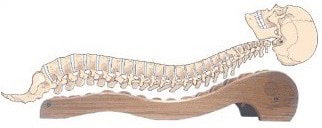
SO, HOW DOES IT WORK?
Patients are instructed to lie on the rack, in a central position, with their knees bent (as shown):
As can be seen from the next diagram, the backrack™ mirrors the natural curvature of the spine. As a result, the back is fully supported: it rests in a neutral position. The wooden nodules push up, on either side of the spine. In turn, this lifts the individual vertebrae (as shown), causing them to pivot about the joints in the back.

As a result of this, the joints are decompressed, and the spine lengthens. Joint mobility (and soft-tissue elasticity) increases.
Stiffness and back pain are therefore reduced.
In addition to this, the pressure on the joints and the intervertebral discs is lowered. This lowers the risk of spinal Osteoarthritis and Bulging or Herniated discs.
Finally, the pressure on the spinal nerves is reduced: this will treat symptoms such as acute local pain, Sciatica and Pins and Needle
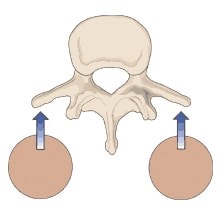
This is very important: the Backrack is designed to remove any unwanted stress on the spine. It will also apply stress that is wanted.
[INSERT VIDEO HERE]
How Backrack™ Device Treats Multiple Causes Of Back Pain?
CONCLUSIONS
The Backrack treats the causes (and hence the symptoms) of back pain. The spine is decompressed, reversing the effects of gravity (as well as injury, bad posture, and old age). If you would like to know more about how the Backrack works, please read our Advanced Explanation. Full details for use of the backrack™ are contained in our Instruction Manual (PDF document).PDFs are exact copies of printed documents. To view this document, you will need Adobe’s Acrobat Reader installed on your computer. You can download this for free from Adobe’s website.
ADVANCED EXPLANATION
In the How does it work section, we explained (briefly) how the backrack works. To explain this in detail, however, we must first describe the structure of the human spine and the main, underlying cause of back pain. From this, the design principles of the backrack™ will become clear.
The human spine consists of a number of vertebrae, or units of bone, arranged in a vertical structure. A structure known as the spinal column.
In new-born children, the column comprises 33 distinct, or physically separate, vertebrae. Over time, however, the units at the base of the column fuse together to form the coccyx, or “tailbone”, and the sacrum, which forms part of the pelvis.
As can be seen from the diagram, the column itself actually consists of five, distinct, regions. These are known (from top to bottom) as the:
- cervical spine (red)
- thoracic spine (yellow)

- lumbar spine (green)
- sacrum (turquoise)
- coccyx (dark blue)
The mechanical function of the spine is two-fold: it must provide structural support for the body, and allow us to move freely in three dimensions (bending over and rotating as necessary).
In order to achieve this, the vertebrae in the top three sections must be allowed to move relative to one another, without compromising the structural rigidity of the back. This is achieved by the use of facet joints, which lock the vertebrae together whilst allowing for articulated movement (an articulated lorry provides a useful analogy).
The joints are referred to as facet joints, because they are formed when the faces of two bones come together. Contrast this, for example, with the hip joint, which consists of a ball and socket.
Facet joints are very good at allowing a broad range of movement. For example, they allow us to bend forward, backwards, and to the side; they also allow us to rotate (both to the left and to the right), and to combine these different movements. Compare this, for example, with the knee, which only allows for bending in one direction: you cannot bend it to the side, or rotate it very far.
Unfortunately, facet joints can also be compressed relatively easily (where the faces slide too far towards each other). When this happens, the vertebrae in the spine can no longer move freely; in turn, this prevents us from moving freely. Put simply, we become stiff. In addition to this, we experience back pain. In actual fact, up to 98% of all back pain is either caused by, or directly linked to, compression of these joints.
If you would like to understand this in more detail, please visit our section on the Back Anatomy.
SO, HOW DOES IT WORK?
Patients are instructed to lie on the rack, in a central position, with their knees bent (as mentioned in the Introduction).
As can be seen from the diagram, the Backrack mirrors the natural curvature of the spine. As a result, the back is fully supported: it rests in a neutral position.
This is very important: the backrack is designed to remove any unwanted stress on the spine. It will also apply stress that is wanted.
In this position, the spine is physically suspended in the central channel. To understand how this happens, consider an individual vertebra, sitting on the rack (as shown):
If you imagine a friend of yours lying on the rack, the view is taken with you looking up the rack from the bottom edge.
Now, each vertebra has a number of processes, thin units of bone that extend from the main section.
The transverse processes extend from either side of the vertebra: these sit on the wooden rollers. The spinous process extends to the rear (it can be seen, and felt, just below the skin in the middle of the back): this sits, suspended in the central channel. The spinous process bears no weight.
The diagram, below, shows what happens from a side-view of the backrack:
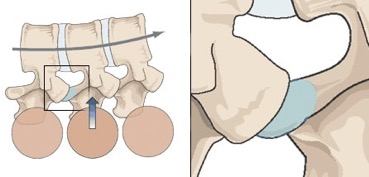
The black square on the left hand side is reproduced, and then magnified, on the right hand side.
The wooden rollers push up under the transverse processes. In turn, this lifts the individual vertebrae, causing them to pivot about the facet joints. As a result of this, the joints are decompressed, and the spine lengthens. Joint mobility (and soft-tissue elasticity) increases; stiffness is therefore reduced.
Recall that up to 98% of all back pain is either caused by, or directly linked to, compression of the facet joints. If we can decompress these joints, something which the backrack™ does, we can treat the causes (and hence the symptoms) of back pain.
In addition to this, the pressure on the joints and the intervertebral discs is lowered. This lowers the risk of spinal Osteoarthritis and Bulging or Herniated discs.
Finally, the pressure on the spinal nerves is reduced; this will treat symptoms such as acute local pain, Sciatica and Pins and Needles.
Full details for use of the backrack™ are contained in our Instruction Manual (PDF document).PDFs are exact copies of printed documents. To view this document, you will need Adobe’s Acrobat Reader installed on your computer. You can download this for free from Adobe’s website.
HOW DO I USE BACKRACK?
TO HELP BACK PAIN
To begin with, patients should lie on the rack as relaxed as possible in a basic central position, with knees bent (as shown, and mentioned earlier).
Achieving this position is actually very easy. For more details, please refer to our section on Getting On
Once in the Starting Position (shown above), patients are encouraged to perform a series of exercises. These have been carefully developed from long experience to mobilise the facet joints of the spine and to reduce as required, back, neck, and hip pain.

When you first lie on the backrack™, you may have a stiff spine and pain/back spasms, because your spine is not accustomed to the pressure. There are no side-effects but your spine will react to the upward force of the nodules with your symptoms certainly improving over the space of about 5 days. You may feel sore the first few days.
In view of this predictable (and necessary) response, the spine needs to be decompressed in stages. To begin with, a low-moderate pressure will be sufficient to lengthen the spine (and provoke a reaction). However, as your spine adapts to the backrack™, you will need to increase the pressure, using more advanced techniques.
For this reason, we have designed a comprehensive range of movements, designed to increase the pressure in stages.
The Basic Exercises decompress the spine using low-moderate pressure. They are suitable for everyone barring a few exceptions, or Contraindications
The Advanced Exercises will decompress the spine using moderate-high pressure (two of them will also help to strengthen the deep, stabilising muscles that support the spine). The Advanced Exercises should not be attempted until you are comfortable with the basic manoeuvres.
If you are in any doubt as to whether the Backrack™ is appropriate for you, please consult your doctor.
HOW OFTEN SHOULD I USE IT?
The Backrack™ can be used as frequently as your body will allow. After each session (possibly the day after) you should expect to feel sore.
This reaction is not the same as back pain. It is simply a natural response from joints that are currently stiff and dysfunctional. It is also a necessary response (without it, you will not get better).
This reaction actually provides a very useful feedback mechanism. When you return to the backrack™ and repeat the exercises, you may find that your back feels uncomfortable and too sore. In this case you should rest. Use the backrack™ on the following day instead.
Alternatively, you could use the backrack™ every day, but perform different exercises on different days. For example, on day 1 you could focus your attention on the lower back using the Single (or Double) Leg Raise; however, on day 2 you could switch your attention to your neck using the Double Leg Raise With Tilt.
You can use the backrack™ as frequently as you like (and for as long as you like) provided that you can tolerate the amount of soreness. To start with, however, we recommend that you use it every other day, and for relatively short periods of time (perhaps 5-10 minutes per session).
After a while you should be able to regulate your own treatment. If you use the backrack™ on a frequent basis, you should find that the soreness disappears. When this happens, you should progress to a more advanced exercise.
IS IT PERFECT?
The Backrack™ is (probably) the best product on the market for the treatment of back pain. Nothing else comes even remotely close and because we have patented the design, no other product is likely to do so for the next 20 years.
However, the backrack™ does have some limitations. It is, after all, a product, not a human being, trained in the field of spinal Orthopaedic Medicine. If you have a serious spinal disorder (for example, a slipped, or Herniated Disc), the backrack™ will help to alleviate your symptoms. You may, however, need to see a specialist, in addition to using the backrack™.
It is, of course, extremely important that you visit the right specialist. In our opinion, the only specialist you should visit is one trained in Orthopaedic Medicine; there is simply no need for anyone to contemplate surgery on their spine (except for a very limited number of cases).
For more details on each of the treatment options available to you, please visit our section on Treatment.
If you would like to make an appointment to see Mr Luklinski (a leading specialist in orthopaedic medicine and the inventor of the Backrack™), please visit our section on the Spine Clinic or our dedicated website, The Luklinski’ Spine Clinic where you will also be able to review Mr. Luklinski’s qualifications and experience and receive a Diagnosis filling the on-line Consultation Form.
GETTING ON AND OFF
Getting on to the Backrack™ is actually very easy. The recommended way is given below. There are other ways to do it, but please follow our instructions. They will help to minimise the strain on your back (this is very important if you have a particularly bad back).
KNEELING DOWN
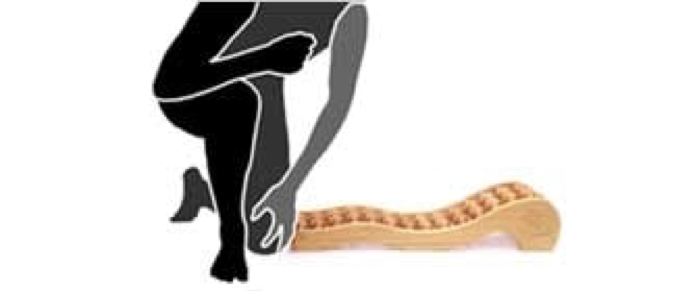
Place the Backrack™ on the floor. Kneel down at the bottom, left-hand corner of the rack.
In this context, bottom left is defined looking down the backrack™, from top to bottom. Ideally, the floor should be carpeted: this will help to cushion your knees (it will also help when Getting Off the rack). Alternatively, place the backrack™ on an exercise mat.
SITTING
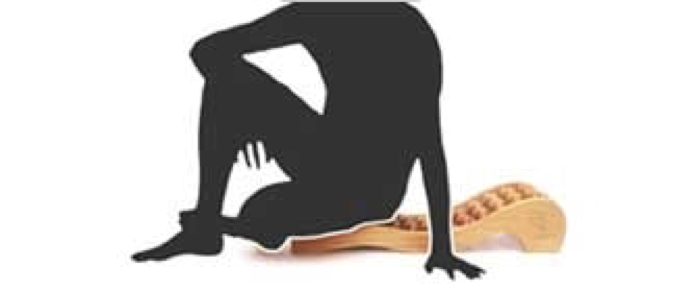
Put your left hand down on the floor, towards the top end of the rack. Put your right hand down, towards the bottom end. Next, lower yourself gently onto the end of the rack (as shown). Adjust your weight, so that you are sitting at the end of the rack, in a central position, with your knees bent. Your legs should be on either side of the centre-line.
SLIDING BACK

Now, slide, or roll yourself backwards along the rack, until you are sitting in the central curve.
The lateral spindles are designed to roll. This will help you in this manoeuvre.
ROLLING DOWN

Now, begin to roll down the rack towards the bottom. At the same time, lean back into the upper curve of the rack. As you continue to roll down, allow your spine to move progressively into the upper curve. It should be supported at all times. Keep your knees bent at all times. Do not straighten your legs (this will strain your lower back).
STARTING POSITION

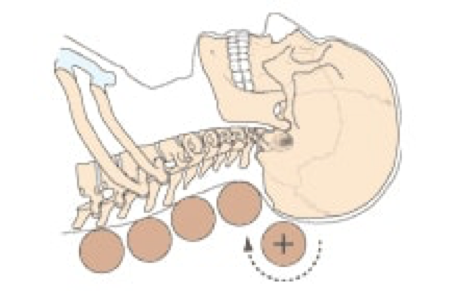
At the end of this manoeuvre, you should be
lying on the rack, with your knees bent, and your spine resting in the central channel (as shown). You should be lying in a central position, with the wooden nodules running down either side of your spine.
The nodules on the last roller should not be in contact with any part of your body. The nodules on the penultimate roller (second down from the top) should be in contact with your upper neck, just below the back of the head. As a result of this, the last spindle should rotate freely.
When you are in the starting position, you can check this by placing your hands behind your neck, and trying to rotate the last spindle. If it will not rotate, you need to move down the rack. If you are too far down the rack, the nodules on the penultimate roller will push into your skull (you will know if this happens). To correct this, you need to slide back up the rack.
GETTING OFF
Getting off the Backrack™ is actually very easy. The recommended way is given below. There are other ways to do it, but please follow our instructions. They will help to minimise the strain on your back (this is very important if you have a particularly bad back).
STARTING POSITION

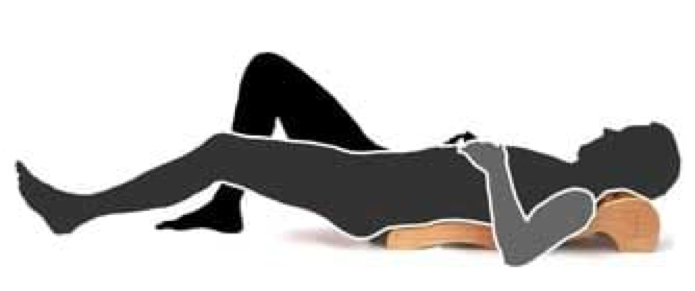
Return to the starting position (as shown). Both feet should rest on the floor, no more than shoulders’ width apart. Next, extend your left leg, with the heel of your foot resting on the floor. Keep your right leg bent.
PIVOT
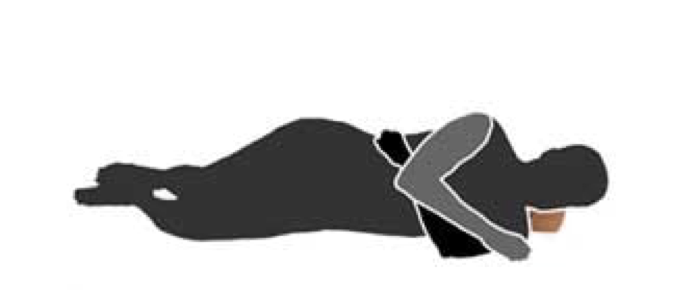
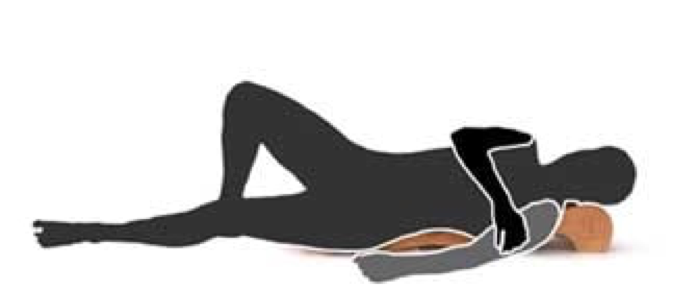
Using your right leg, push into the floor. At the same time, rotate your head and upper body towards the left hand side of the rack.
Complete this part of the manoeuvre by rolling onto the floor. Your legs should now be together and bent (as shown).
LIFT

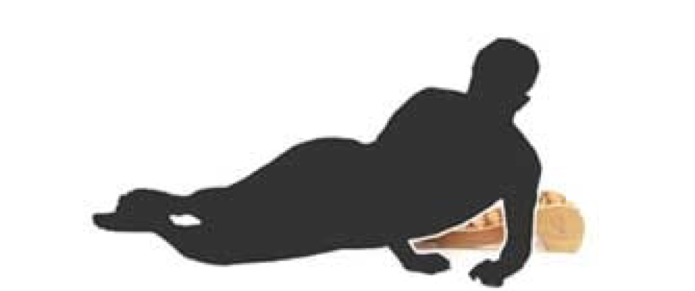
Using your right hand, lift yourself up so that you are resting on your left forearm (as shown). At this stage, your legs should still be together.
Next, push yourself up with your forearm until you are resting on your left hand. The sole of your right foot should rest on the floor.
Finally, put your right hand on the floor in front of you. Push off with your right foot and both hands. As you do this, swing your left leg under your body so that you rest on your left knee (and the sole of your right foot). Push up with your right leg until you are standing.
BASIC EXERCISES TO TREAT BACK PAIN
BACKRACK – HOW DO I USE IT?
The basic exercises will decompress your spine using low-moderate pressure. They are suitable for everyone (barring a few exceptions, or Contraindications).
The exercises appear in order of ascending difficulty (and/or pressure). We therefore recommend that you are comfortable with each manoeuvre, before trying the next one. If you are in any doubt as to whether the backrack™ is appropriate for you, please consult your doctor.
STARTING POSITION

The neutral, or starting, position is suitable for people with moderate-severe back pain. Achieving this position is actually very easy. For more details please visit our Getting On section.
A small amount of pressure is applied to the spine, and you are not required to move (the spine rests in a neutral position).
If you have a bad neck, you can rotate your head to one side. This will shift the weight of your head over the corresponding side of your neck, increasing the amount of pressure in this region. If you need to reduce the amount of pressure, place a folded towel behind your neck.
SINGLE LEG RAISE
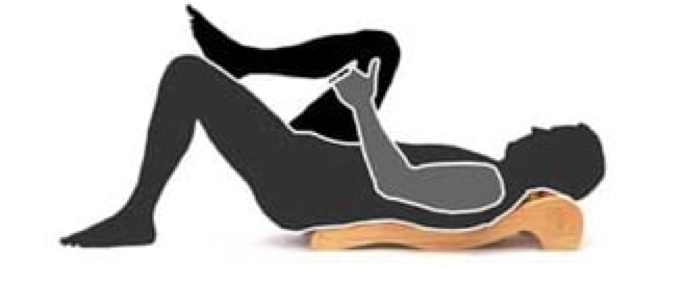
When you feel comfortable with the starting position, bring up one of your legs towards your chest.
This will shift the weight of your leg over the corresponding side of your lower spine, increasing the amount of pressure in this region. It will also help to stretch your hamstring muscle: this runs down the back of your upper leg.
After holding this position for a short period of time (perhaps 30 seconds), return your leg to the floor and raise the other leg.
Please make sure that you grasp your leg behind the knee (as shown). This will prevent the knee from being squashed. You can alter the exact point of pressure by varying the angle of your leg, bringing it closer to your chest, as and when you feel comfortable. If you have had a bad (lower) back for a long period of time, your hamstring muscles will be tight. You should therefore approach this exercise carefully. Bring your leg towards your chest in small increments.
DOUBLE LEG RAISE
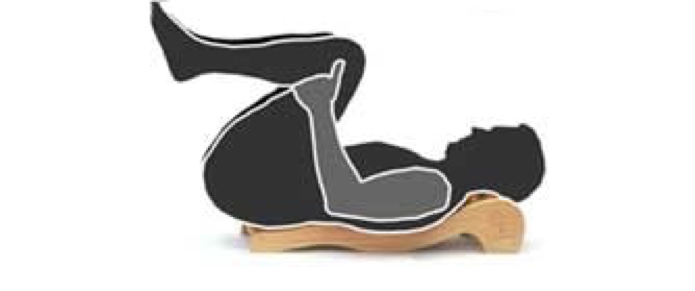
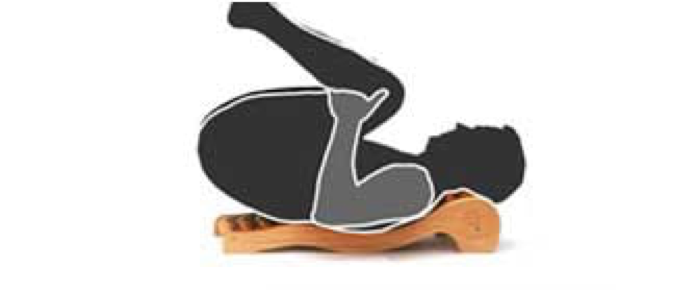
The double leg raise will increase the pressure on your lower spine. It shifts the
weight of both legs over your lower back. Again, please make sure that you grasp each leg behind the knee.
After holding this position for a short period of time (perhaps 30 seconds), bring your legs further towards your chest (as shown).
Again, hold for 30 seconds, and repeat until your legs are as high as possible.
If you have had a bad (lower) back for a long period of time, your hamstring muscles will be tight. You should therefore approach this exercise carefully. Bring your leg towards your chest in small increments.
BACKWARDS TILT
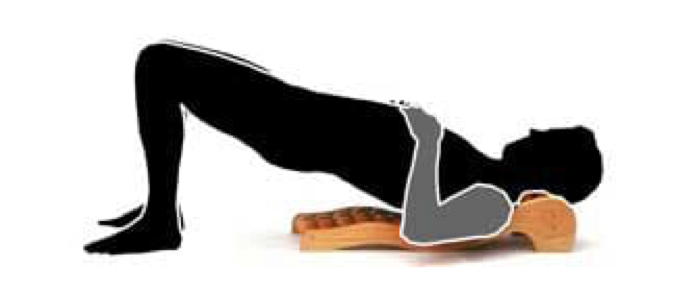
The backward tilt will increase the pressure on your neck. The diagram below is largely self explanatory. You can alter the exact point of pressure by varying the angle of your legs. If you have had a bad (lower) back for a long period of time, you may find that you have weak knees. You should therefore approach this exercise carefully. Do not hold the position for too long. It is better to hold the position for a short period of time, and to do a larger number of reps (or repetitions). Finally, remember to keep breathing throughout the exercise.
|
Weight |
5 kg |
|
SIZE |
LARGE [1.75m and 2.00m tall (5′ 9″ to 6′ 6″)], |

